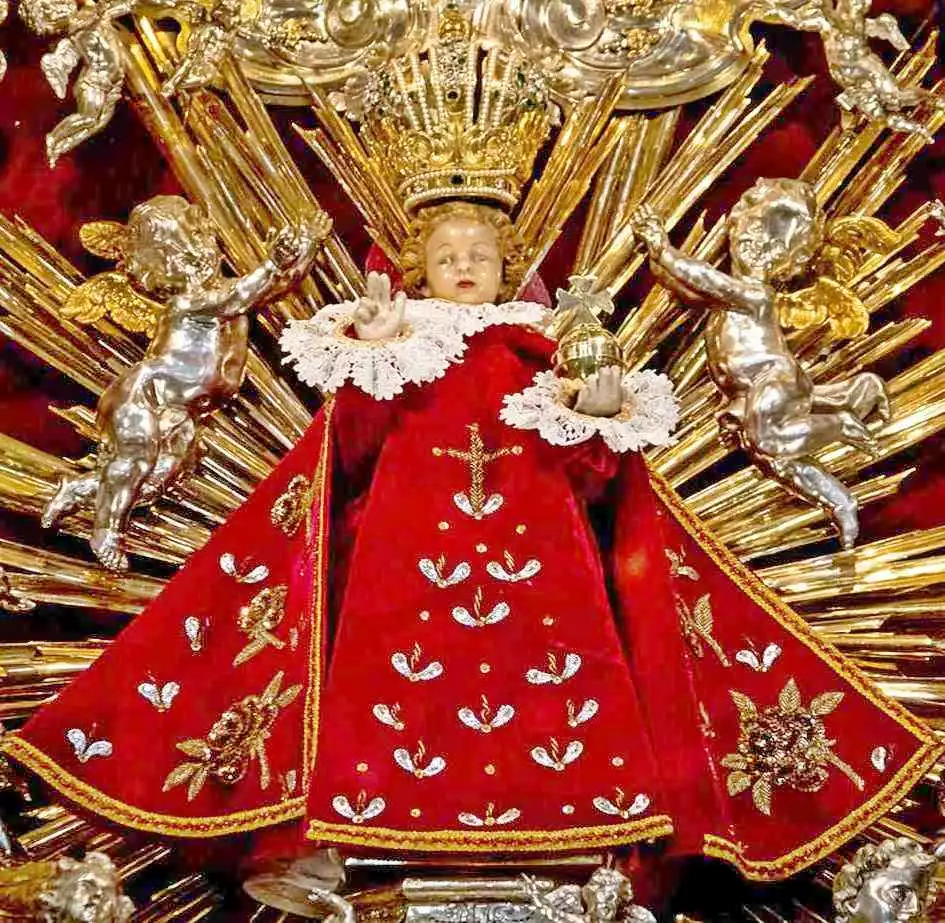
The original statue of the Infant Jesus of Prague was created as a royal wedding gift from a Spanish Princess to her Austrian royal cousin in the 16th century. Over time, the effigy of the Christ Child became affiliated with mystical legends and miracles that fueled devotion in Prague and beyond. To this day, copies of the endearing figurine are revered around the world.
Origins of the Enchanting Infant Jesus of Prague Sculpture
The Infant Jesus statue has captivated devotees for centuries, but its exact origins were shrouded in intrigue for years. The effigy is believed to have first appeared in 1556, when the statuette traveled from Spain to Bohemia. Princess Maria Manriquez de Lara y Mendoza brought the sculpture to Bohemia upon her betrothal to a Czech nobleman. The 19-inch wooden figurine depicts Jesus as a child, adorned in fine fabrics and holding a globus cruciger representing Christ’s dominion over earth. Could this unassuming statue really possess mystical qualities as legends claim?
By some accounts, the statuette was carved by an unnamed Spanish monk who had a divine vision. Other records suggest Princess Maria’s mother acquired it from the esteemed Teresa of Ávila. Over time, the infant Jesus icon became an heirloom passed down noble bloodlines. When Princess Polyxena of Lobkowicz wed in 1587, she received the statue as a wedding gift. So how did this dainty effigy with suspected magical powers end up housed in a Prague monastery?
In 1628, Princess Polyxena made the fateful decision to gift the statue to the Discalced Carmelite Friars residing in Prague’s Church of Our Lady of Victory. She implored: “Venerable Fathers, I bring you my dearest possession. Honor this image and you shall never be poor.” Had she unknowingly unleashed aLegend has it that while war wreaked havoc on Prague years later, the figurine became damaged and forgotten. But miracles have a way of recurring, even after decades.
The account remains unfinished, awaiting further details on this cryptic history. One thing is clear – the infant Jesus icon conceals more enigmas than its petite frame suggests.
Legends and Devotion Surrounding the Prague Statuette
The infant Jesus statuette continued to demonstrate its mysterious nature after being housed in the Church of Our Lady of Victory. According to local legend, the statue was discarded during war in the 1600s only to resurface seven years later. The figurine’s hands had been destroyed, but as Carmelite monk Fr. Cyril prayed before it one day, a shocking incident occurred. The story goes that Fr. Cyril heard an unexpected voice saying: “Have mercy on me, and I will have mercy on you. Give me hands, and I will give you peace.” Was this merely lore conjured over time or a bonafide miracle?
After purportedly speaking, the statue was said to bestow blessings and luck to its petitioners. Claims arose of the figurine healing the sick, protecting children during wartime, and securing victory in battle. Word of its supernatural feats drew pilgrims from surrounding regions hoping to witness wonders. Even royalty took notice. Historical accounts suggest emperors and nobles financed luxurious garments and jewels to adorn the Infant Jesus statue through the ages. Clearly, the innocuous carving maintained an air of mystery.
By 1655, devoted Prague citizens honored the sculpture with a full coronation ceremony attended by dignitaries. As the decades passed, reproductions appeared across Europe and beyond. Still today, Catholic churches worldwide exhibit copies of the Infant Jesus, publicizing the promise: “The more you honor me, the more I will bless you.”
Over four centuries since its emergence, the Infant Jesus of Prague statue continues sparking intrigue and devotion. The effigy’s affiliation with legends of divine visions, miraculous healings, and supernatural speech still fuel spiritual worship across the globe. Though its origins contain mysteries, the icon’s lasting ability to evoke piety and wonder persists.
References
McDannell, Colleen, and Bernhard Lang. Heaven: A History. 2nd ed., Yale University Press, 2001.
Pitt, Leonard, et al. The Catholic Encyclopedia for School and Home. McGraw-Hill, 1965.
Zibura, John S. From Whence It Came.” Marvels, Mysteries and Miracles in the Catholic Church, Sophia Institute Press, 2021, pp. 231–276.
